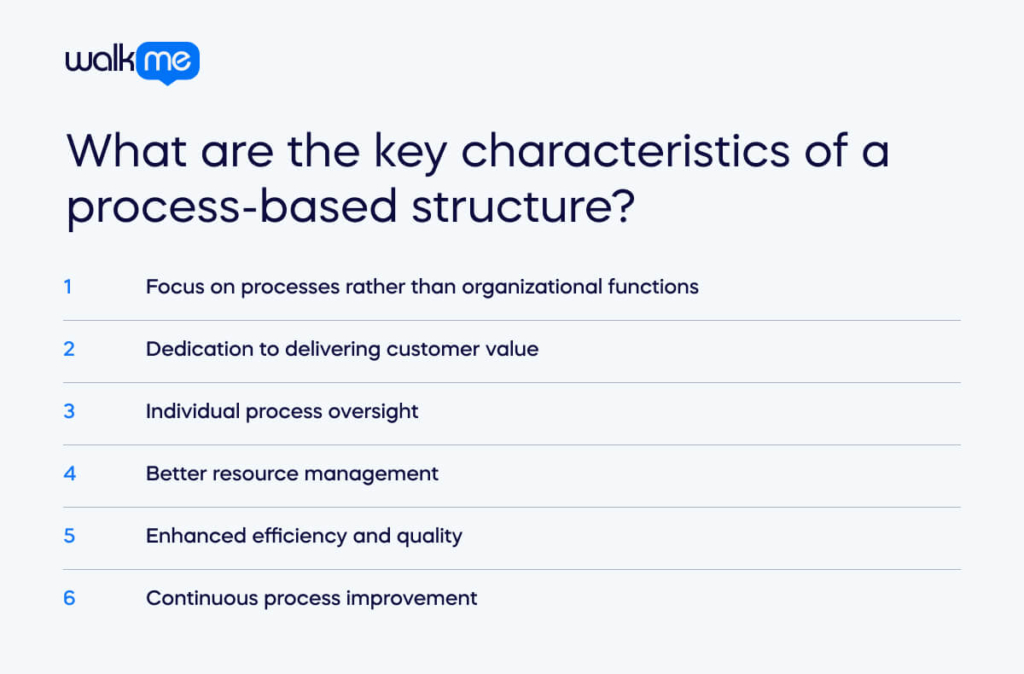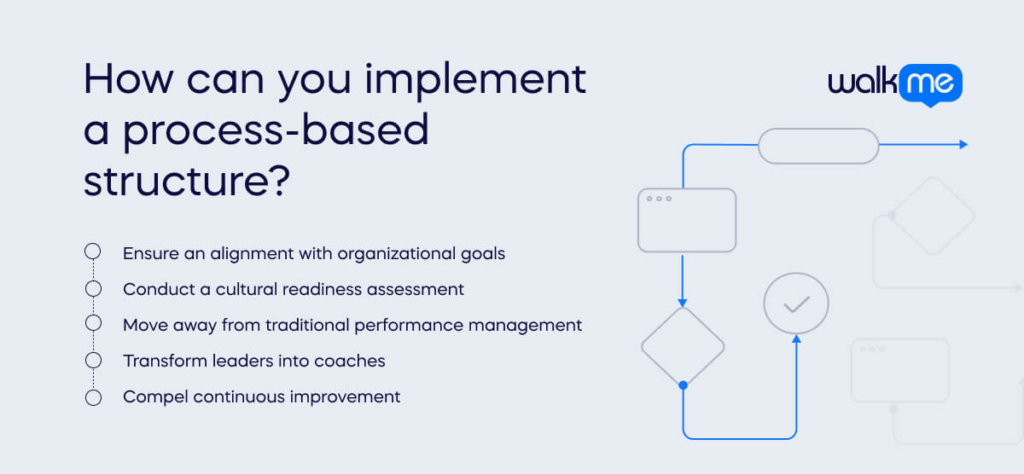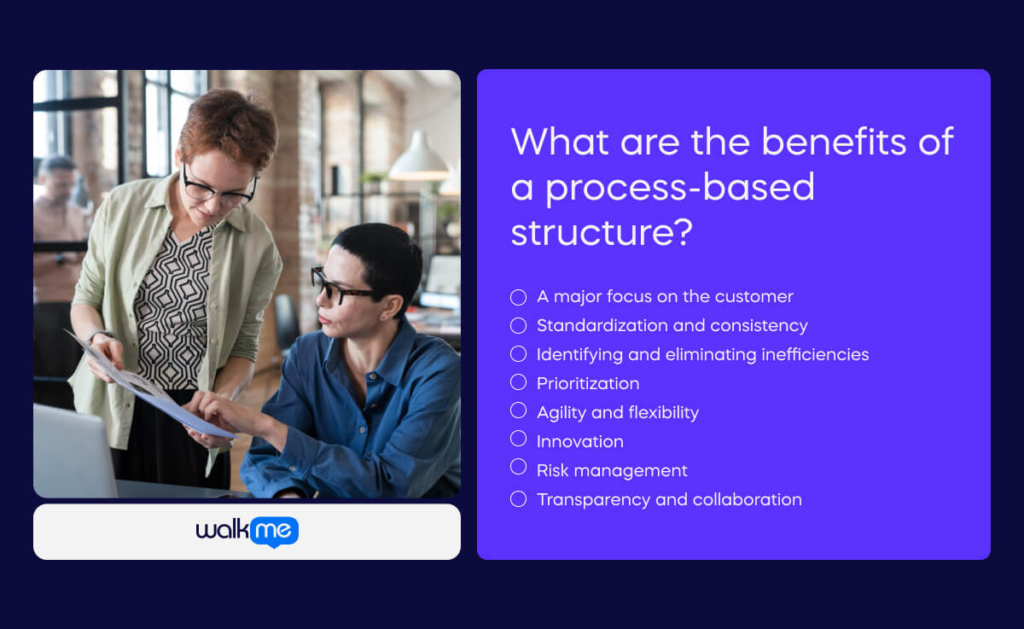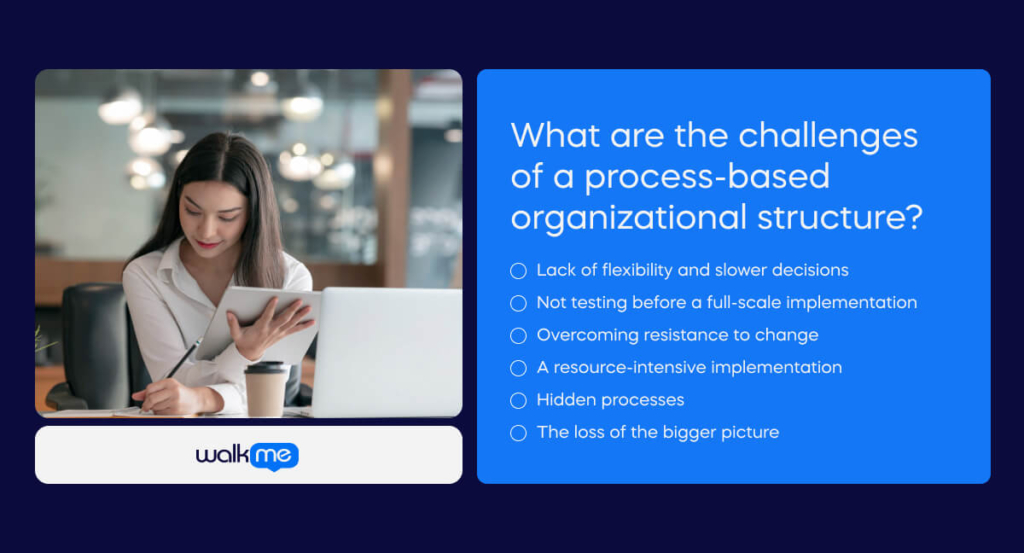Processes define organizational design by regulating business practices and shaping performance. Companies can structure themselves around processes that deliver products and services, with the goal of improving operations, reducing bottlenecks, and eliminating resource wastage.
The process-based structure not only enables better organizational development but also supports continuous improvement. However, adopting or shifting to this model often requires effective change management to ensure teams adapt smoothly and new practices are embedded successfully.
In this article, we will explore what a process-based structure is and its key characteristics. We will compare it to a functional structure, examine its benefits and challenges, and outline implementation steps with an example.
What is a process-based structure?
In a process-based structure, the organization designs itself around the flow of its processes. It focuses on how the duties performed by employees interact with one another. Instead of flowing from top to bottom, this structure outlines services from left to right.
An executive oversees the departments below, representing different processes. Each process starts only after the previous one finishes. Each department has its management and team working to fulfill its duties. This allows the business to move on to the next task until it reaches its ultimate goal, such as selling a product to consumers.
What are the key characteristics of a process-based structure?

The vital elements of a process-based structure are:
Focus on processes rather than organizational functions
In a process-based organization, business processes take center stage. Outputs flow between processes rather than between organizational units, emphasizing process efficiency and effectiveness.
This approach does not need downsizing. However, it aims to reduce bureaucracy and end work that adds no value. When implemented, it introduces new roles and processes that deliver customer engagement and support long-term success.
Dedication to delivering customer value
The process-based structure enhances flexibility and responsiveness to changes in customer needs. Focusing everyone’s attention on the customer boosts customer satisfaction, productivity, speed, and efficiency. Employees adopt a holistic view of organizational goals. This approach transcends departmental boundaries and enables a cross-functional team.
Individual process oversight
Each process within the organization has a dedicated process owner or manager responsible for overseeing its performance, improvement, and alignment with organizational goals.
Better resource management
The organization can provide resources based on the strategic importance of each process division to its success.
Enhanced efficiency and quality
The structure focuses on optimizing key processes and eliminating redundancies. It can also improve workflows to enhance efficiency and maintain high-quality standards.
Continuous process improvement
Organizations utilizing this structure emphasize process improvement methodologies. These include Kanban, 5 Whys, Six Sigma, and Lean to enhance their operational processes.
What is the difference between a process-based and a functional organizational structure?
A functional structure arranges employees based on their specific skills within the company. In contrast, a process-based structure organizes employees into groups according to the steps of a process.
Here are the major differences between the two:
| Process-based structure | Functional structure | |
| Employee duties | Consider how all tasks relate to each other. This is irrespective of the department | Each employee has their own goals, dependent on the department |
| Systems | All employees share data and systems to work towards a collaborative goal | Each employee in a department has their own data and systems |
| Type of management | Horizontal | Vertical |
| Organizational division | Based on functions and activities | Based on sectors or departments |
What is an example of a process-based structure?

Here is a real-world example of how a process-based structure works:
Atlassian, a software company known for products like Jira and Confluence, employs a process-based structure to streamline its product development and customer support processes. The company divides its operations into specific process-focused teams, each dedicated to different aspects of the business.
The product development team focuses on creating and improving software products. This team includes roles such as product managers, software developers, UX/UI designers, and quality assurance testers. They follow a structured process that begins with ideation and requirement gathering, moves through design and development, and ends with testing and deployment. Regular sprint reviews and retrospectives ensure continuous improvement and alignment with customer needs.
Meanwhile, the customer support team is dedicated to assisting and resolving user issues. This team is divided into sub-teams that handle different types of support, such as technical troubleshooting, billing inquiries, and onboarding assistance. Customer support representatives use tools like helpdesk software and knowledge bases to provide efficient and effective service. They follow a process that starts with ticket triage, moves through issue resolution, and concludes with follow-up to ensure customer satisfaction.
These process-based teams innovate their services in their own way, leveraging specialized knowledge and expertise. The product development team might implement new development frameworks and methodologies, while the customer support team could introduce advanced support tools and training programs. By focusing on specific processes, Atlassian ensures each team operates efficiently and contributes to the company’s overall success.
How can you implement a process-based structure?

Here are some tips for implementing a process-based structure:
- Ensure an alignment with organizational goals
A process-based organization addresses alignment challenges. First, it should align core business processes with enterprise goals. This alignment involves organizing the organization to support and meet process needs.
This means you organize teams based on work roles rather than job titles. Process sponsors review core business processes. Next, process managers plan and improve process performance and resource allocation. Process owners design, enable execution, manage, and improve core processes.
These roles aim to integrate processes, ensuring they contribute to organizational goals. You can manage conflict between functional and process managers through clear communication.
Process sponsors play a crucial role in appointing dedicated process owners or managers. They can ensure processes meet quality, timeliness, customer satisfaction, and cost goals, ensuring ongoing improvement that matches organizational objectives.
- Conduct a cultural readiness assessment
Cultural readiness is crucial before implementing a process-centric approach. Executives must ensure their organization embraces a process culture. This is where business processes are integral to decision-making and continuous improvement efforts.
Before adopting this type of culture change, leaders need to source employees’ feedback. This will help them understand what their staff needs to make the change. Structural changes alone are insufficient without a supportive cultural environment.
- Move away from traditional performance management
Process-based organizations need to shift from focusing on departmental or functional goals. Instead, they should adopt a performance management process. These can promote collaboration and influence from many directions.
They also need to implement new appraisal systems. These include peer reviews, 360-degree feedback, and team evaluations. The system should also account for reward structures like skill-based pay and team bonuses.
- Transform leaders into coaches
Top and middle management in process-based structures play a crucial role. They support frontline entrepreneurship. They integrate their diverse knowledge and best practices across business units. This type of cross-training enhances the organization’s responsiveness to agile and competitive environments.
- Compel continuous improvement
Effective management and control of business processes are essential to benefiting from a process-based organization. This includes planning, implementing, and monitoring processes to ensure efficiency, effectiveness, and continuous improvement.
You should define performance indicators (KPIs) to measure the success of each process. Based on these metrics, regular assessments should be conducted, and processes should be adjusted to improve performance over time.
What are the benefits of a process-based structure?

The many benefits of a process-based structure include:
A major focus on the customer
Process-centered companies can solve these problems because they focus on the customer. Adopting a process view means doing whatever you need to create customer value. Unlike traditional structures that have fixed responsibilities, a process-based approach is flexible. It focuses on delivering value and reduces customer churn.
Standardization and consistency
A process-based structure emphasizes standardization and consistency. By defining and documenting processes, you can ensure that employees perform tasks well, which improves quality control and customer satisfaction.
Clear objectives and scope for each process make it easier to identify issues. This aligns with Deming’s cycle for continuous improvement.
Identifying and eliminating inefficiencies
This structure allows organizations to identify and end bottlenecks. It can also reduce redundancies and inefficiencies in their operations. By streamlining processes, organizations reduce waste, which improves productivity and enhances efficiency.
Prioritization
Process-based systems are easier to sequence and focus on for development. Processes’ dependencies are understood through their inputs and outputs. This approach facilitates piloting and refining systems and improves adoption over big-bang deployments.
Agility and flexibility
Well-managed processes enable organizations to respond to changing market conditions. They also help adhere to customer demands or regulatory requirements. Agile methodologies, such as the fishbone diagram, focus on continuous improvement and flexibility.
Innovation
Cross-functional teams within process-based organizations foster innovation. They do this by bringing together diverse perspectives and expertise. This collaboration enhances problem-solving and creativity.
Risk management
A process-based structure helps identify and mitigate risks. Documenting processes and implementing controls reduces errors, minimizing compliance issues and enhancing risk management practices.
Transparency and collaboration
This structure clearly explains how employees work within an organization. Transparency allows stakeholders to identify areas for improvement, which helps in making informed decisions and collaborating across departments.
What are the challenges of a process-based organizational structure?

But, a process-based structure also comes with disadvantages like:
Lack of flexibility and slower decisions
In some cases, excessive processes can lead to bureaucracy and rigidity. This slows down decision-making and stifles innovation. To avoid these drawbacks, you must balance standardization and flexibility. A business process spans many people and departments, including IT, finance, and security.
Not testing before a full-scale implementation
Lack of performance testing can lead to process breakdowns and unforeseen errors. It can also lead to operational challenges and new security risks. When planning new processes, you need to consider staging and sandbox environments.
You should also examine security controls. Use automated testing tools to measure process performance. To eliminate vulnerabilities, include an IT developer or specialist in the test build process.
Overcoming resistance to change
It can be difficult to balance process needs with the organization’s goals. Introducing process-based initiatives may face resistance from employees, who might be comfortable with existing ways of working. So, achieving the adoption of new processes can be a challenge.
A resource-intensive implementation
Developing and implementing robust process management practices can be time-consuming and resource-intensive. It requires dedicated personnel, training, and ongoing monitoring, which can strain organizational resources.
Hidden processes
Business processes often evolve over time because users find better ways to solve minor problems. This gradual evolution results in hidden processes you have failed to identify. These processes can break down when people move to other positions and cause problems when circumstances change.
The loss of the bigger picture
Organizations must not lose sight of the bigger picture. Your focus on processes could be at the expense of creativity and strategic thinking. This can limit growth and innovation.
Key takeaways of a process-based structure
Process-based structures differ from traditional ones in several key ways. They focus on designing and managing entire business processes rather than individual tasks. They also measure and manage results at the process level instead of departmental efficiency. Then, they prioritize customer goals over localized functional goals.
This approach leverages the full potential of processes. Process-based organizations focus on the relationships between different functions. This makes them more flexible, adaptive, and responsive than traditional organizations.
They handle changes better by organizing around core business processes. Rather than rigid functions, this creates a more natural fit between work and structure.
This method helps overcome coordination problems. It also delivers more value to customers. It provides a competitive advantage through shorter cycle times and higher product quality.
Consider the main challenges you want to solve when adopting a process-based structure. Identify the needed resources, skills, and people. Plan your new structure. Share your plans with leadership before telling everyone. Be ready to make small changes every few months as you learn to use your talent and resources better.

Frequently Asked Questions
By organizing around end-to-end workflows, a process-based structure breaks down departmental silos, fostering collaboration across functions. This alignment enhances efficiency and customer satisfaction by ensuring cohesive operations.
Leadership must champion the shift by setting a clear vision, allocating resources, and promoting a culture that values process optimization. Their commitment is crucial for overcoming resistance and ensuring successful implementation.
Effectiveness can be assessed through key performance indicators (KPIs) such as process cycle times, customer satisfaction scores, and error rates. Regular monitoring helps in continuous improvement and aligning processes with strategic goals.
Challenges include resistance to change, the complexity of redesigning processes, and potential overlaps in responsibilities. Addressing these requires clear communication, training, and a phased implementation approach.
By focusing on processes, organizations can better integrate digital technologies to automate workflows, enhance data analytics, and improve decision-making, thereby accelerating digital transformation efforts.

